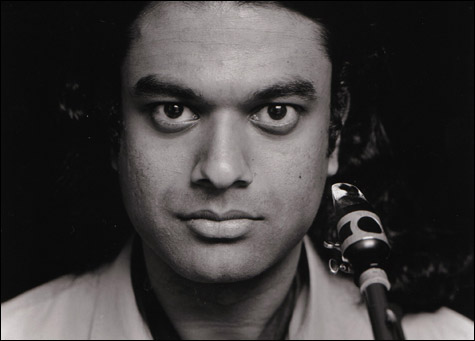|

MIX MASTER: A Colorado native, Mahanthappa needed to hear Indian music “completely on my own terms” before embracing it.
|
WFNX Jazz Brunch Top 5: Week of February 10
1. Pat Metheny, Day Trip [Nonesuch]
2. Omar Sosa, Afreecanos [OTA]
3. Holly Cole, Holly Cole [Koch]
4. Chick Corea/Gary Burton, The New Crystal Silence [Concord]
5. Maceo Parker, Roots and Grooves: A Tribute to Ray Charles [Heads Up]
|
The connection between jazz and India is at least as old as John Coltrane’s composition named for that country. So it stands to reason that Rudresh Mahanthappa — a jazz musician, the Colorado-raised son of Indian immigrants — would be expected to have the inside line on the Indo-jazz connection. “A lot of people know that Indian music is improvised, and everyone knows that a good part of jazz is improvised,” Mahanthappa tells me over the phone. “So people seeing the color of my skin assumed that I must know a ton about Indian music. People made that assumption when I was 18 or 19 — and that was something I was running away from.”
Mahanthappa, now 36, is one of the more celebrated young musicians of his generation, a critics’-poll winner and Guggenheim fellow with an original compositional style rooted in jazz and, yes, Indian music, rich in rhythmic and melodic complexity, with an aggressive attack on alto saxophone. His fat tone and fearsome articulation give his improvisations a Coltrane-like sweep and grandeur. It’s a trait he also shares with one of his teachers from his days at Berklee, George Garzone. Mahanthappa, who comes to the Isabella Stewart Gardner Museum with his quartet on February 21 (as a complement to the Gardner’s current Indian-themed “Luxury for Export” exhibit), tells a story familiar to many first-generation children of immigrants. It’s one of musical and cultural crossover, and typically American.
“If you look at any elementary school in most major cities now, you’ll find at least one if not a few Indian kids,” he points out. “But back when I was in school, there were hardly any Indian-Americans around.” His father was an academic, a high-energy theoretical physicist (“a string-theory guy”) who’d come to the States as part of a ’50s wave of immigration to study at Harvard. By the time Rudresh was born, his family were part of the University of Colorado community in Boulder. “I don’t speak my parents’ language, which I regret now, but I can also see that as a kid not speaking their language was kind of a way to rebel and be more American. For me, it was just kind of safer, and my default mode was to think of myself as white.”
But in college, at North Texas State (now the University of North Texas), he discovered a new level of racism (“It was Texas, even if it was north Texas instead of south”). There was another big difference between Denton, Texas, and Boulder: “I’d never seen that many black people in my life except for the time I went to a Grover Washington concert in junior high.”
Mahanthappa had been taking saxophone lessons since fourth grade, and by ninth grade he knew he wanted to be a professional musician. A summer-school session at Berklee sealed the deal, and by junior year of college he had transferred and was living in Boston. Although he had played in funk and jazz bands, his epiphany came in 1994 when he visited India with a Berklee student ensemble and heard a concert in Bangalore by the classical North Indian singer Parween Sultanta. “It was incredibly soulful, emotional but totally virtuosic and amazingly complex music. And she had some of the best rhythmic sense I’ve ever heard, period.” That’s when he began to dig into Indian music in earnest. “I had needed to hear the music completely on my own terms, and when I was able to do that, it was like, ‘Oh my God, this is as amazing — if not more amazing — than my favorite John Coltrane bootleg from 1965!’ ”
To a jazz fan’s ear, though, the India in Mahanthappa’s own music may be secondary. By now, Indian music has been thoroughly absorbed into jazz through Coltrane and others, and the raga-like spinning of complex melodic and rhythmic patterns in “exotic” scales over droning static harmonies has become commonplace. But Mahanthappa’s work is just as much in the vein of latter-day composer-improvisers like Steve Coleman and Greg Osby (both of whom he’s worked with), with their jumping, angular lines and odd-metered excursions, and the use of drones mixed with chord-based patterns and free improvisation. Since 1996, he has been collaborating with the Indo-American pianist Vijay Iyer (who will be part of the quartet at the Gardner), and their music is its own branch of the current avant-jazz style.